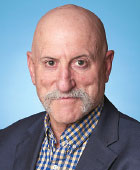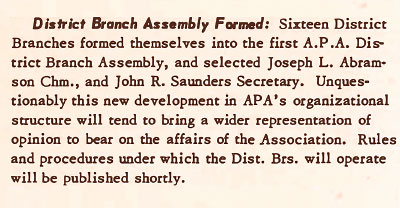A History of the APA Assembly from A (Alabama) to W (Wyoming)
Abstract
The APA Assembly was created in 1953 and through the years has become an important venue for ensuring that a wide range of voices and ideas are heard from APA members and allied organizations.

The history of the APA Assembly is a tortuous one, with APA Assembly members stutter stepping their way to the current purpose, makeup, and functioning of the Assembly. That’s not a criticism but merely a description. Perhaps a series of metamorphoses was the only way the Assembly could have achieved the meaningful role it plays in APA today.
The first meeting of the Assembly of District Branches occurred on May 5, 1953, in Los Angeles, where the temperature reached 94 degrees, by far the hottest day that week. There were 16 district branches at the time (four from New York state), and all attended the meeting. But the Assembly did not actually start out this way.
Prior to the Assembly’s formal formation, at each Annual Meeting there was a town-hall gathering where APA business was conducted and officers elected. Since 1892, APA had had an elected “Council” (now the Board of Trustees), who acted on behalf of the membership between meetings. In the 1940s dissatisfaction with the effectiveness of APA and its capacity to respond to the needs of the membership had become quite apparent.
The 1940s was not the first time APA wrestled with restructuring. William Allison White, in his 1925 presidential address, suggested forming “sections” and within them “district societies.” This model was implemented. In a decision that would come back to haunt APA, membership in the independent sections and district societies did not require APA membership. Eleven years later, the sections were dispensed with, district societies became “affiliated societies,” and “district branches” (DB) were created. APA decided then on a unified membership rule: If one is a member of a DB, one must be a member of APA, and if one is a member of APA, one must be a member of a DB.
This did not exactly fix the problem of non-APA members being actively involved in APA affairs. Since there were still affiliated societies that could include nonmembers, these grew in number, and not one DB was formed until 1949, or 13 years after the unified membership rule was established.
Emerging from this quagmire was another clarion call for change. The Council appointed the Reorganization Committee to look at reorganizing APA and appointed Karl Menninger as its chair. The outcome was a recommendation that APA function with a House of Delegates that made policy and a Council that carried out the policies (similar to the AMA model). As one can imagine, this was not popular with many APA members. Two camps emerged, fractious debates ensued, and this structure was rejected.

This news item appeared in the May 1953 APA Newsletter, produced by APA’s Information Service.
Some of the other committee recommendations were adopted, most notable of which was the formation of a central office under the direction of a medical director. The Reorganization Committee reorganized and recommended the creation of the Assembly of District Branches, whose representatives would meet and consider only those matters sent to it by the Council.
In 1949, there were 27 affiliate societies and no DBs. The first two DBs were approved by APA that year: the Pennsylvania DB (which included Delaware) and the Mid Continent DB (Missouri and Kansas). In the ensuing years, as DBs formed, they often included more than one state.
In 1952 the APA Bylaws were amended, and the Assembly of District Branches was official. By the first meeting in 1953, there were 16 DBs as already noted. The Assembly’s first-year budget was $500. That’s equivalent in purchasing power to about $4,830.92 in 2020. The Assembly’s 2020 budget is $1,361,318.
Almost as quickly as a group can change its mind, the Assembly pushed back against the idea that it could consider only matters referred to it by the Council. Before the second Assembly meeting, the DBs suggested a change so the Assembly could also initiate recommendations to the Council. The Council approved this. It took until the third Assembly meeting for the members to do so. The Central California Psychiatric Society applied for membership at the 1953 meeting and was accepted, making it the first DB on the West Coast. Its annual dues were $1. At the 1954 meeting, the Assembly organized itself into five regions; from the outset, New York was its own region, but neither the Mid-Atlantic states nor California were regions at this point.
The Assembly grew quickly in the early years as members perceived the benefit of being in a DB so as to be able to influence the direction of APA: 1953, 16 DBs; 1954, 21 DBs; 1955, 23 DBs; 1956, 31 DBs; 1957, 35 DBs. One has to credit New York state* as figuring the Assembly out early on. New York added one DB per meeting in four of the first five meetings. By 1958, the Assembly had 45 DBs. At the meeting that year, the affiliated members category was designated to refer to nonpsychiatrist physicians with an interest in psychiatry.
The Assembly of District Branches Comes of Age
On May 7, 1963, Assembly Speaker Robert Garber, M.D., presented Assembly delegates with a “Ten Point Program for the Assembly of District Branches.” Garber told the delegates that “the District Branches have reached that point in their development where they are an indivisible part of the whole organizational structure of APA.” The ten points were as follows:
Build branch membership. About 4,000 psychiatrists at that time were known not to hold APA membership. The branches were urged to undertake active recruitment.
Support your branch and your national Association. This would include, among other things, a lively newsletter, divisional meetings, and the establishment of chapters and/or regional groupings in appropriate cases.
Establish a staff facility for your branch.
Support adequate appropriations for public psychiatric hospitals.
Assume leadership in state and community mental health planning councils.
Expand and consolidate close working relationships with medical societies.
Develop and expand general and private hospital psychiatric services.
Redouble efforts to educate other physicians in psychiatry.
Actively support and work with the citizens’ mental health movement.
Work to improve the public image of psychiatry
At the time of the 1959 Assembly meeting, there were 48 DBs. Ninety APA members attended the meeting and decided this was about the maximum number the Assembly could have and function in an effective parliamentary fashion. At the most recent Assembly meeting in November 2019, there were 246 voting members.
The eighth Assembly meeting, in 1960, passed a noteworthy resolution: “The ancillary personnel in mental hospitals need some leadership, and APA should take responsibility for this leadership.”
By the time of the ninth Assembly 1961 meeting, APA had 6,000 to 7,000 members and 53 DBs. Only two states were not represented by a DB, West Virginia and Alabama. But again, some DBs represented more than one state. For example, the Intermountain Psychiatric Association represented psychiatrists in Arizona, Idaho, Montana, Utah, Wyoming, and Nevada except for the Reno area. The total number of psychiatrists represented by this DB was 80.
New York state kept chugging along. By the end of the 10th Assembly meeting, the state had accrued three additional DBs. Other states were forming chapters, which was the Assembly’s preference.
I’m going to stop this year-by-year analysis after covering the 11th Assembly meeting in 1963, as this was the watershed year for the Assembly. It was here that the Assembly decided it needed to meet twice a year. And it was here that Speaker Robert Gardner put forth his “Ten Point Program for the Assembly of District Branches” (see box). The Assembly has strayed very little from these admonitions.
The Assembly of today struggles with many of the same issues as it did during its first dozen years and has debated many times since: the relationship between the Board of Trustees and the Assembly; the role of the professionals “not holding M.D. degrees in allied mental health fields” (as they were referred to in 1964); the optimal size of the Assembly (once thought to be one-third of the current size of the Assembly); should a state have more than one DB or one DB with chapters; how many regions should there be; a recommendation that the Joint Commission (known at the time as the Joint Commission on Accreditation of Hospitals) re-evaluate its methods for surveying psychiatric facilities; recruitment of residents as members to increase membership; and how to deal with insurance companies (in 1965 the new UAW contract had a provision for psychiatric coverage of workers’ dependents).
That’s not to say the Assembly hasn’t evolved. From an organization of older white men**, the Assembly has evolved into an APA operation as diverse as the membership it serves. The Assembly has not only diversity in those who represent DBs but now has 14 members designated as early career psychiatrists, 14 as minority and underrepresented psychiatrists, 14 as resident-fellow members, and 20 representatives of affiliate organizations of psychiatrists (ACROSS members). And the Assembly is modifying its activities, adapting to the need to be efficient and effective. Who would have thought on that hot day in L.A. in 1953 that someday the Assembly would have both a consent calendar and a reaffirmation calendar?
The Assembly faces a new challenge at this time. It’s belt-tightening time at APA, and the Assembly, like the rest of APA, needs to figure out how to do at least what it’s doing with fewer resources. The Assembly has been here before. Let’s see what happens this time. ■
*I acknowledge a potential conflict: I was born in New York and educated in its public school system grades K-12.
**I confess I am one of these.
The author thanks the following individuals for providing written materials used in the preparation of this article: Deena Gorland, Jack McIntyre, M.D., and Allison Moraske.



